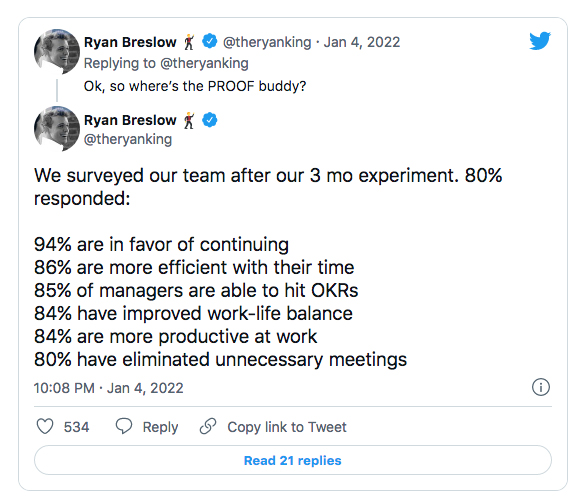The 4-Day Work Week: Why It Works and How To Implement It
Learn the benefits of a 4-day work week, potential downsides, and how to implement one like companies with 4-day work week experience in this post now:

Think the 4-day work week should become the new global standard? Many top companies with 4-day work week goals feel the same way.
Countries like Spain, Iceland, and Belgium are even pushing legislation and earmarking funds to help local businesses make this a reality.
With ripples from The Great Resignation still disrupting teams, employers are finally realizing the need to prioritize a healthier work-life balance. And working one less day per week seems to help.
That’s why a staggering 92% of US workers say they’re on board with 4-day work week models.
The only trick? Actually implementing one.
Despite the many benefits, some potential downsides and setbacks may arise without a careful transition to this new schedule.
So in today’s guide, we’ll explore the pros and cons of the 4-day work week, lay out an implementation plan, and take a cue from some of the biggest companies with 4-day work week experience.
But first, let’s make sure we’re all on the same page by answering:
What is the 4-Day Work Week?
The 4-day work week refers to a model in which full-time employees only work four days out of the week instead of the standard five (typically Monday through Friday). This gives employees three days off per week instead of two.
When it comes to compensation, companies can choose to:
- Pay employees for five days (even though they only worked four).
- Only pay employees for four days.
- Ask employees to work four 10-hour shifts instead of five 8-hour shifts.
- Pay overtime for any hours worked over 32 for the week.
Depending on your company, you may let your employees choose their days off, have a blanket Fridays-Off rule, or work different seasonal hours (think: a No-Bad-Mondays Winter).
So Why is the 4-Day Work Week Gaining Traction?
As employers start to pull out of The Great Recession, they’re becoming savvier about attracting and retaining top talent. This starts with paying teams fair, equitable salaries and offering the most competitive employee benefits packages.
But the most in-demand companies know they must emphasize stronger support for mental health in the workplace, especially for remote teams. Telecommuters often struggle to disconnect from work and suffer from higher rates of loneliness, stress, and burnout.
Ironically, the transition to remote work became a major catalyst for the four-day work week trend.

The COVID-19 pandemic taught the world what most remote companies have known for years: that people can be more productive working from home.
Many remote teams are so productive that they don’t even make their employees track their time or clock-in to the virtual workspace. They trust their employees to work when it’s most productive and convenient for them to do so.
As long as they meet their deadlines and continue collaborating effectively, they can work five days of short, intense sprints or three highly-productive days per week. And more workers are craving this type of schedule flexibility.
Besides strict time management skills, a big reason for this extra productivity has to do with the rise of better remote work tools.
The 4-Day Work Week, Sponsored By Big Tech
The 4-day work week is entirely possible thanks to recent tech advancements. Experts say the Fourth Industrial Revolution started in 2000 and brought an explosion of digital tech to make our lives easier.
From AI that automates batch tasks to The Internet of Things, these leaps in technology have improved productivity so much that we can work (and stress) less.
Now cloud-based tools and software like project managers, virtual meeting platforms, and smart assistants make it possible for workers to score all the benefits of having one more day off.
4 Benefits of the 4-Day Work Week (+ Potential Downsides To Consider)
Before your company dives head-first into a 4-day work week, you should know all the upsides and downsides of this model:
Pro: Better Work-Life Balance
Ever wake up on Monday morning and wonder where the weekend went?
With so many chores, errands, and returning social commitments, there’s hardly ever time to really relax. Experts say having an extra day off could be the missing link to achieving the disconnect from work we all desperately need.

Imagine having an entire day you can spend with your kids or on self-care, creative thinking, or hobbies and interests that bring you joy.
Another option? Making room in your schedule for a better health and wellness routine.
How often have you backburned a doctor’s appointment or teeth cleaning because these offices were only open during the weekdays and you had too much to get done?
According to the Centers for Disease Control (CDC), productivity losses related to personal and family health problems (including absenteeism and reduced work output due to burnout) cost US employers $1,685 per employee per year, or $225.8 billion annually.
Having an extra day off Monday through Friday would allow employees to take care of their mental and physical health without losing productivity or vacation time. And the more employers address their workers’ well-being, the higher productivity rates trend.
Pro: Higher Employee Productivity
Many of the most productive countries in the world have employees who only work an average of 27 hours per week. What’s their secret? Happy employees.
The Organization for Economic Cooperation and Development reported that “happy employees who work shorter workweeks are more productive than stressed employees who work overtime.”
This confirms what researchers in another study learned, that “happiness made people around 12% more productive.”

When teams aren’t constantly stressed to the max, they can approach complex tasks with clear thinking. They work smarter, not harder. And that extra productivity and well-being are so worth the extra day off.
Pro: Earn a Top Recruiting Advantage
According to recent reports, remote job searches have increased 460% since the Covid pandemic. Job seekers are specifically looking for WFH roles thanks to perks like flexible work arrangements.
So if you want your remote company to really stand out, advertising a shortened work week in your job ads will get more applicants to apply. Then you’ll have your pick of top talent worldwide.
A shorter work week appeals to current and potential employees because it shows your company values its team members. And value alignment is also a significant competitive advantage.
Pro: Higher Retention Rates
Your stellar, hand-picked team may be less likely to turnover post 4-day work week transition.
When Spanish software firm Delsol implemented a four-day work model, they maintained near-perfect employee retention rates. Full disclosure: they also boosted their teams’ remote technology and hired more remote employees to provide adequate coverage.
Con: Implementation Takes Careful Research To Get Right
Transitioning from a 5-day to 4-day work week takes careful research, collaboration with department leaders, and lots of employee input. You’ll need to create new work policies with HR and discuss potential payroll and time off rules.
You must also consider how this change will affect your clients or customers. If your entire team takes Mondays off, will your B2B customers be upset when they reach out for support and find no one home?
Con: Leaders May Have To Change Expectations or Hire More Remote Employees
Removing one day from the work week may pressure employees to accomplish more in less time. So there needs to be a fundamental mindset shift to focus on productivity, not just hours worked or projects completed.

Your company may need extra hands on deck to meet coverage demands or complete everything in your project management flow on time. The good news is that the remote candidate market is bursting with talent.
When done right, there are more advantages than disadvantages to the 4-day work week. And some of the biggest global companies are blazing the trail for others to follow their lead.
8 Companies with 4-Day Work Weeks
Here are a few highlights from what some companies with 4-day work weeks have learned:
1. Perpetual Guardian. One of the first companies to adopt the 4-day work week, this New Zealand planning firm transitioned its 240+ employees back in 2018. Higher productivity, a 20% boost in customer engagement levels, and a 26% improvement in work-life balance followed.
2. Microsoft (Japan). The tech giant gave its 2,300 employees paid leave on Fridays during the summer of 2019, and noticed productivity jumped 40%.
3. Delsol. The 4-day work week helped the software firm decrease employee absenteeism by 28%, earn more revenue, and earn better employee and customer satisfaction rates.
4. Basecamp. The remote Basecamp team holds “summer hours,” which are 32-hour 4-day work weeks from May 1 through August 31.
5. Buffer. A whopping 91% of employees were happier, less stressed, and more productive after Buffer tried the 4-day work week. So the company extended 4-day work weeks indefinitely.
6. Kickstarter. Kickstarter now allows its employees to permanently work remotely and take Fridays off.
8. Bolt. When the San Francisco-based eCommerce startup made a permanent switch to 4-day weeks (by giving Fridays off), they gained 280 new employees.

In a tweet, Bolt CEO Ryan Breslow said that the company was “never going back” to 5-day work weeks due to all the positive perks the 4-day model delivered.
Even though these companies make it look easy to switch to a new 4-day work week, it still requires research, planning, and experimentation to get right.
How To Implement a 4-Day Work Week
Ready to start taking Fridays off forever? Here’s how to implement a 4-day work week at your remote company:
1. Focus On Your Why
What’s the biggest reason you want to switch to a 4-day model? Recruiting help, employee satisfaction, and operational efficiency are all excellent reasons. But narrowing down your top one will help you craft a protocol laser-focused on achieving this goal.
2. Gather Your Leaders To Discuss Impacts
Think about the impact this switch will have on your team, clients, customers, and other stakeholders. Consider both sides of the coin during your discussions: how this will benefit and create possible problems for them.

You won’t be able to anticipate everything that might go wrong, but you can minimize the risk of negative outcomes during your transition. Remember: this will be a time of growth for your organization, and some things may need a bit of trial and error to work out.
Advice from The Harvard Business Review suggests team leaders discuss questions like:
- How long should we run this pilot?
- How will the organization measure productivity?
- How can we keep the change from negatively impacting our clients and customers?
- What support will employees, customers, etc., need to make this pilot a success?
- What steps can we take to increase our productivity?
These answers may tell you whether you can adopt a simple Fridays-off model or need a custom 4-day work week schedule.
3. Pick HR’s Brain
Your HR and payroll team will need to weigh in on potential labor concerns you must be aware of with this transition. Will asking employees to work fewer hours affect how they earn overtime and time off, take vacations, become eligible for employee benefits, etc.
If so, they’ll need to create a new remote work policy that specifically addresses these new rules or requirements. You might also need to run these changes by your legal team.
4. Brainstorm Potential Schedule Models
Your scheduling and coverage needs should guide your organization’s days off.
After speaking with leaders, you might learn that Fridays are the least productive days, making Fridays off a no-brainer.